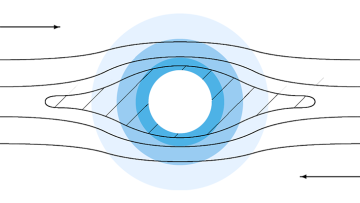Delivering the 2016 IMA Lighthill Lecture was not only a great honour, but also an opportunity to reflect on the influence of Sir Michael James Lighthill (1924–1998). Of course, he is well known to this audience as the founder of the IMA and Lucasian professor at Cambridge. He is remembered worldwide as a pioneer in theoretical fluid mechanics, especially in aeroacoustics and swimming, which was also his passion in real life.

Personally, I first came across the work of Lighthill, when I was trying to calculate the induced-charge electro-osmotic flow around a polarisable particle and its resulting electrophoretic motion. Half a century later, his seminal paper on the ‘squirming’ motion of micro-organisms
provided a useful mathematical framework that could also be applied in this context. Lighthill’s emphasis on broken symmetries in swimming also foreshadowed recent developments in induced-charge electrophoresis.

Like many applied mathematicians, I also came to know the Lighthill-Whitham theory of kinematic waves, in traffic flow (Figure 1) through my teaching. This turned out to be a fateful experience, since it prepared me to understand shock waves in other, unexpected areas of my research. This background helped me to develop (with A. Mani) a simple mathematical model of deionisation shocks in charged porous media
sustained by surface conduction and electro-osmotic flow
(Figure 2). Guided by the theory, I set out to develop the principles and applications of ‘shock electrochemistry’ in my new experimental laboratory, after I joined the Department of Chemical Engineering in 2008. Recent examples (Figure 3) include shock electrodialysis,
a method of water desalination and purification, and shock electrodeposition,
a means of controlling metal growth for nanotechnology or batteries.

In the lecture, my reflection on Lighthill thus naturally led to the main topic of Nonequilibrium thermodynamics of Li-ion batteries. For the mathematical details and a historical account of this work, let me refer to a recent review and simply provide some highlights from the lecture. Traditional battery models describe ion transport by diffusion, in both the liquid electrolyte and the solid electrode, but this assumption breaks down for some of the most popular advanced electrode materials, such as iron phosphate and graphite, which separate into stable phases with different lithium concentrations. To address the problem, over the past ten years, I developed general modelling framework unifying non-equilibrium thermodynamics with electrochemistry. The theory is based on the Cahn-Hilliard equation,
extended for chemical kinetics and charge transfer,
where the reaction rate may be localised on a boundary for heterogeneous reactions (the ‘Cahn-Hilliard reaction model’) or distributed throughout a volume for homogeneous reactions (the ‘Allen-Cahn reaction model’).
In traditional battery

modelling, the open circuit voltage versus state of charge is fitted to experimental data, which amounts to relating the lithium chemical potential in the solid to the (assumed) uniform concentration in equilibrium, when diffusion stops. In multiphase systems, however, equilibrium does not imply constant concentration, but instead constant (diffusional) chemical potential, defined as the variational derivative of the total Gibbs free energy functional. The new theory thus has a fundamentally different starting point, putting all the constitutive physics into the free energy functional, rather than the voltage profile. In this way, complicated effects of configurational entropy, elastic coherency strain and diffuse charge are consistently incorporated into the formulation of chemical reaction kinetics.

The mathematical theory has led to some surprising predictions about nanoscale kinetics in the prototypical two-phase battery material, lithium iron phosphate (LFP):
- Intercalation waves (moving phase boundaries) sweeping across the active crystal facet,
rather than penetrating the bulk like a shrinking core;
- Suppression of phase separation in nanoparticles during battery discharge;
- Striped patterns of phase separation, resulting from coherency strain;
- Nucleation by surface ‘wetting’ of solid phases in nanoparticles;
- Mosaic instability (discrete particle transformations) in porous electrodes, depending on the applied current and particle size distribution.
All of these predictions have since been visualised in situ during battery operation (Figure 4), a remarkable feat that will continue to shed light new phenomena, guided by mathematical modelling. This connection between theory, experiments, and applications follows in the tradition of British applied mathematics, led by Lighthill.
Martin Z. Bazant
Departments of Chemical Engineering and Mathematics, MIT
References
- Crighton, D. (1999) James Lighthill, Physics Today, vol. 52, p. 104.
- Bazant, M.Z. and Squires, T.M. (2004) Induced-charge electro-kinetic phenomena: Theory and microfluidic applications, Phys. Rev. Lett., vol. 92, no. 6 pp. 1–4.
- Lighthill, M.J. (1952) On the squirming motion of nearly spherical deformable bodies through liquids at very small reynolds numbers, Comm. Pure Appl. Math., vol. 5, pp. 109–118.
- Bazant, M.Z. and Squires, T.M. (2010) Induced-charge electrokinetic phenomena, Current Opinion in Colloid and Interface Science, vol. 15, no. 3, p. 203–213.
- Lighthill, M.J. and Whitham, G.B. (1955) On kinematic waves. II. A theory of traffic flow on long crowded roads, Proceedings of the Royal Society of London A: Mathematical, Physical and Engineering Sciences, vol. 229, no. 1178.
- Mani, A. and Bazant, M.Z. (2011) Deionization shocks in microstructures, Physical Review E, vol. 84, no. 6.
- Nam, S. et al. (2015) Experimental Verification of Overlimiting Current by Surface Conduction and Electro-osmotic Flow in Microchannels, Phys. Rev. Lett., vol. 114, no. 11.
- Schlumpberger, S. et al. (2015) Scalable and continuous water deionization by shock electrodialysis, Environ. Sci. Technol. Lett., vol. 2, pp. 367–372.
- Han, J.-H., et al. (2014) Overlimiting current and control of dendritic growth surface conduction in nanopores, Scientific Reports 4, 7056.
- Han, J.-H., et al. (2016) Dendrite suppression by shock electrodeposition in charged porous media, submitted, http://arxiv.org/abs/1505.05604
- Bazant, M.Z. (2013) Theory of chemical kinetics and charge transfer based on nonequilibrium thermodynamics, Accounts of Chemical Research, vol. 46, pp. 1144–1160.
- Singh, G., Ceder, G. and Bazant, M.Z. (2008) Intercalation dynamics in rechargeable battery materials: General theory and phase-transformation waves in LiFePO
, Electrochim. Acta, vol. 53, pp. 7599–7613.
- Bai, P., Cogswell, D.A. and Bazant, M.Z. (2011) Suppression of phase separation in LiFePO
nanoparticles during battery discharge, Nano Letters, vol. 11, pp. 4890–4896.
- Cogswell, D.A. and Bazant, M.Z. (2012) Coherency strain and the kinetics of phase separation in LixFePO
, ACS Nano, vol. 6, pp. 2215–25.
- Cogswell, D.A. and Bazant, M.Z. (2013) Theory of coherent nucleation in nanoparticles, Nano Letters, vol. 13, pp. 3036–3041.
- Ferguson, T.R. and Bazant, M.Z. (2014) Phase transformation dynamics in porous battery electrodes, Electrochim. Acta, vol. 146, pp. 89–97.
- Li, Y. et al. (2014) Transition between particle-by-particle and concurrent intercalation in phase-separating battery electrodes, Nature Materials, vol. 71, pp. 183–188.
- Lim, Y. et al. (2016) Nanoscale variation of Li-insertion rate controls compositional spatio-dynamics within battery primary particles, submitted.
Reproduced from Mathematics Today, June 2016
Download the article, The IMA Lighthill Lecture at BAMC (pdf)



